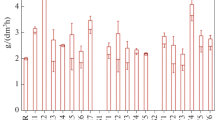Abstract
Objective
To reduce the fermentation cost in very high gravity fermentations of ethanol using Saccharomyces cerevisiae, whole cell directed evolution approaches were carried out.
Results
The methods used included cell ploidy manipulation, global transcription machinery engineering and genome shuffling. Ethanol production by the four methods was improved compared with the control. Notably, the ethanol yield of a strain constructed by genome shuffling was enhanced by up to 11 % more than the control reaching 120 g ethanol/l in 35 h using a very high gravity fermentation with 300 g glucose/l.
Conclusion
Genome shuffling can create strains with improved fermentation characteristics in very high gravity fermentations.


Similar content being viewed by others
References
Alper H (2006) Development of systematic and combinatorial approaches for the metabolic engineering of microorganisms. PhD Thesis, Massachusetts Institute of Technology, pp 21–34
Alper H, Moxley J, Nevoigt E, Fink GR, Stephanopoulos G (2006) Engineering yeast transcription machinery for improved ethanol tolerance and production. Science 314:1565–1568
Bhaumik SR, Green MR (2002) Differential requirement of SAGA components for recruitment of TATA-box-binding protein to promoters in vivo. Mol Cell Biol 22:7365–7371
Bidenne C, Blondin B, Dequin S, Vezinhet F (1992) Analysis of the chromosomal DNA polymorphism of wine strains of Saccharomyces cerevisiae. Curr Genet 22: l–7
Cao LM, Zhang AL, Kong QX, Xu X, Josine T, Chen X (2007) Overexpression of GLT1 in fps1△gpd△ mutant for optimum ethanol formation by Saccharomyces cerevisiae. Biomol Eng 24:638–642
Devantier R, Scheithauer B, Granato VS, Pedersen S, Olsson L (2005) Metabolite profiling for analysis of yeast stress response during very high gravity ethanol fermentations. Biotechnol Bioeng 90:703–714
Gong J, Zheng H, Wu Z, Chen T, Zhao X (2009) Genome shuffling: progress and applications for phenotype improvement. Biotechnol Adv 27:996–1005
Hou LH (2009) Novel methods of genome shuffling used in Saccharomyces cerevisiae. Biotechnol Lett 31:671–677
Hou LH (2010) Improved production of ethanol by novel genome shuffling in Saccharomyces cerevisiae. Appl Biochem Biotechnol 160:1084–1093
Hou LH, Cao XH, Wang CL, Lu MF (2009) Effect of overexpression of transcription factors on the fermentation properties of Saccharomyces cerevisiae industrial strains. Lett Appl Microbiol 49:14–19
Hou LH, Cao XH, Wang CL (2010) A novel approach for the improvement of ethanol fermentation by Saccharomyces cerevisiae. Can J Microbiol 56:1–6
Kong QX, Cao LM, Zhang AL, Chen X (2007) Overexpressing GLT1 in gpd1Delta mutant to improve the production of ethanol of Saccharomyces cerevisiae. Appl Microbiol Biotechnol 73:1382–1386
Lee TI, Causton HC, Holstege FC, Shen WC, Hannett N, Jennings EG, Winston F, Green MR, Young RA (2000) Redundant roles for the TFIID and SAGA complexes in global transcription. Nature 405:701–704
Lin Y, Tanaka S (2006) Ethanol fermentation from biomass resources: current state and prospects. Appl Microbiol Biotechnol 69:627–642
Nevoigt E, Stahl U (1997) Osmoregulation and glycerol metabolism in the yeast Saccharomyces cerevisiae. FEMS Microbiol Rev 21:231–241
Nissen TL, Hamann CW, Kielland-Brandt MC, Nielsen J, Villadsen J (2000) Anaerobic and aerobic batch cultivations of Saccharomyces cerevisiae mutants impaired in glycerol synthesis. Yeast 16:463–474
Ostergaard S, Olsson L, Nielsen J (2000) Metabolic engineering of Saccharomyces cerevisiae. Microbiol Mole Biol Rev 64:34–50
Patnaik R (2008) Engineering complex phenotypes in industrial strains. Biotechnol Progr 24:38–47
Pronk JT (2001) Stoichiometry and compartmentation of NADH metabolism in Saccharomyces cerevisiae. FEMS Microbiol Rev 25:15–37
Rautio JJ, Huuskonen A, Vuokko H, Vidgren V, Londesborough J (2007) Monitoring yeast physiology during very high gravity wort fermentations by frequent analysis of gene expression. Yeast 24:741–760
Salmon JM (1997) Enological fermentation kinetics of an isogenic ploidy series derived from an industrial Saccharomyces cerevisiae strain. J Ferment Bioeng 83:253–260
Schiestl RH, Gietz RD (1989) High efficiency transformation of intact yeast cells using single stranded nucleic acids as carrier. Curr Genet 16:339–346
Tamás MJ, Karlgren S, Bill RM, Hedfalk K, Allegri L, Ferreira M, Thevelein JM, Rydström J, Mullins JG, Hohmann S (2003) A short regulatory domain restricts glycerol transport through yeast Fps1p. J Biol Chem 278:6337–6345
Teixeira MC, Godinho CP, Cabrito TR, Mira NP, Sá-Correia I (2012) Increased expression of the yeast multidrug resistance ABC transporter Pdr18 leads to increased ethanol tolerance and ethanol production in high gravity alcoholic fermentation. Microb Cell Fact 11:28
Zhang YX, Perry K, Vinci VA, Powell K, Stemmer WPC, Cardayre SB (2002) Genome shuffling leads to rapid phenotypic improvement in bacteria. Nature 415:644–646
Zhang AL, Kong QX, Cao LM, Chen X (2007) Effect of FPS1 deletion on the fermentation properties of Saccharomyces cerevisiae. Lett Appl Microbiol 44:212–217
Acknowledgments
This work was supported by the National Natural Science Foundation (31371819) and the projects (2012AA022108, 2013AA102106, 2012BAD33B04 and IRT1166).
Author information
Authors and Affiliations
Corresponding author
Rights and permissions
About this article
Cite this article
Hou, Lh., Meng, M., Guo, L. et al. A comparison of whole cell directed evolution approaches in breeding of industrial strain of Saccharomyces cerevisiae . Biotechnol Lett 37, 1393–1398 (2015). https://doi.org/10.1007/s10529-015-1812-6
Received:
Accepted:
Published:
Issue Date:
DOI: https://doi.org/10.1007/s10529-015-1812-6




